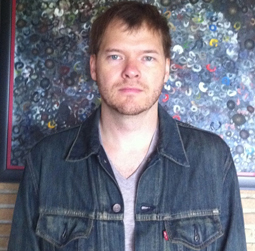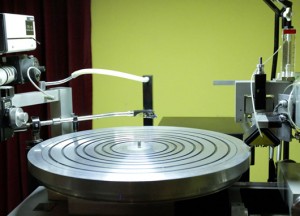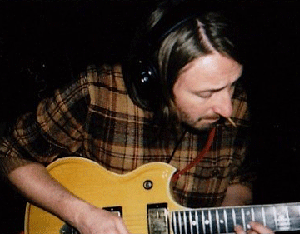Vinyl Revival: Infrasonic Sound, L.A.
EAST LOS ANGELES: For Pete Lyman, mastering engineer and co-founder of L.A.’s Infrasonic Sound, ‘revival’ is not the right word for what’s happening with vinyl. In his world, the format never died in the first place.
The 37-year-old came up in punk and hardcore bands releasing 7” records, and as a music fan, never made the transition to CDs. His friends in the business, the bands he’s recorded like No Age, and his colleagues at Infrasonic, have always thought about music in terms of vinyl.
“Everything from the length of a record, to how it’s sequenced, to how we lay down individual tracks in the recording studio,” he says, “We’re always thinking about how it will translate to vinyl because – to us – vinyl is the only important format.”
From a business perspective, however, Lyman will allow for some of this revival talk. He’s been at it long enough now to see a couple waves of business, and over the last few years, a “sometimes overwhelming” demand for his vinyl mastering and cutting services.
“There isn’t a day that’s gone by in the last eight months that I haven’t cut vinyl,” he notes. “It’s so busy that, for me, just vinyl could fill up 50 hours a week, non-stop.”
Business has been so busy, in fact, that Infrasonic is relocating its mastering and two-lathe vinyl facilities to a much larger space within a new 4,000 sq. ft. complex in Echo Park. Vinyl record sales were up by 40% in 2011, and Lyman traces the growth back several years. This is not a passing trend. So, for Lyman and the other major players in the vinyl business, the goal now is to inform the music community about the technical process and the creative and sonic potential of this classic format, which – to the youngest generation of artists – is a totally new concept.
“Even now that we’re cutting a lot of records, vinyl is still an afterthought for a lot of people,” Lyman says. “They know they want to do it, and they know it sells. But a lot of people still miss the point about how great a record can sound, especially compared to a CD, when mastered and cut on a properly set-up system.
“For younger bands, a 55-minute record or more, is a normal length,” Lyman continues. “We’ll go through an album mastering session for CD/digital, and a week down the line, they want to do vinyl as well. And when I tell them they’ll have to cut a couple tracks, they’re shocked.”
Instead many artists will try to push the physical limitations of vinyl, Lyman says, without understanding the risks if they do, or the rewards if they don’t.
“The 7” format was created for 2 ½ minute pop songs. Now it’s very typical to have a 7” with over 4 or even 5 minutes,” he says. “7”s typically don’t sound very good anyway – especially for loud distorted rock music that’s exceeding the recommended playing length by twice the amount of time. So we have to tell people – yes, you can cut a 5-minute 7” at 45 and it may sound good, but you also have to understand the limitations.”
Since vinyl is such a core part of what makes Infrasonic tick (they even offer direct-to-disc recording!), the entire studio business and brand have blossomed along with the increased interest in the format. Acclaimed indie bands like Fools Gold, Wavves and Telepathe along with major label projects like The Mars Volta, Beck and Kenny Wayne Shepherd have all recorded here. Lyman counts People Under The Stairs, Best Coast, The Jesus Lizard and Trash Talk among his many mastering clients. And rather atypically for a mastering engineer, he still occasionally produces and engineers records – most recently, No Age’s Everything Inbetween and Wilderness’ (k)no(w)here.
So there’s a certain amount of built-in clientele – vinyl-minded bands and labels like Sub Pop, and No Age drummer Dean Allen Spunt’s label Post Present Medium – clients who understand how to best work with the format.
For example, No Age, a raucous noise-punk duo, will edit a song down to fit on 7”, or, says Lyman “they’ll adjust their expectations on how loud it can be, and how much low end content can be included.”
Or, if you’ve got the budget, you can push it and see what happens. “You can do 26-minute sides,” Lyman allows. “I did a 26 and a half-minute side for Ben Harper’s last record, but it’s not the best solution. It turned out good in that case, but only because we were able to cut a lot of references, and did a lot of test cuts. But really it’s best to understand the time limitations and try to work within them instead of trying to fight them.”
THE VALUE OF VINYL
To instruct on all this and more, Lyman and a panel of peers will discuss “The Value of Vinyl” in a panel event at SXSW this Saturday (3/17). Lewis Pesacov of the LA-based band Fool’s Gold and White Iris Records will moderate, and spokespeople from Dorado Packaging, United Record Pressing, and Record Store Day will round out the panel.
Pesacov, who’s a guitarist, composer and producer (Best Coast, Nikki Lane), recently told The Vinyl District, “In an increasingly virtual world, I believe the analogue and physical is becoming more and more important.”
If that rings true with music fans, vinyl has a real future. And artists, labels engineers and producers should all be versed in how to make it work for them.
“Vinyl is the only really viable physical format,” Lyman points out. “And I think it’s here to stay because I don’t think we’ll see another physical format come out and be embraced.”
In that sense, it’s a format with no competition. Digital isn’t competing with vinyl. Digital is about convenience. “Physical product has to be something that people have an emotional connection to,” Lyman suggests. “And you have no emotional connection to the however-many-thousands of MP3s you have on your computer.”
“But a piece of vinyl with a big 12” cover and an amazing piece of artwork and liner notes, that is physical. And the process of sitting down and dropping the needle on a record, and actually being an engaged listener – that’s an experience, and that’s the biggest thing, to me, about vinyl. The experience.”
For more on Infrasonic and Pete Lyman, visit http://www.infrasonicsound.com. And if you’re in Austin for SXSW, check out “The Value of Vinyl” panel from 3:30 – 4:30 at the Austin Convention Center, Room 17B.
Please note: When you buy products through links on this page, we may earn an affiliate commission.










beatlefan1970
March 14, 2012 at 8:47 pm (13 years ago)This pleases me no end. I love the fact that so many artists I actually like are pressing vinyl again!
beatlefan1970
March 14, 2012 at 8:47 pm (13 years ago)This pleases me no end. I love the fact that so many artists I actually like are pressing vinyl again!
Guest
March 22, 2012 at 10:10 pm (13 years ago)Great article
Mrgrumpy
June 6, 2012 at 8:16 pm (13 years ago)Hate to be a
party pooper, but how much vinyl pressed today is really analog? And isn’t that supposedly the whole point – to deliver a superior sound to CD? I’d wager 99.99% of vinyl today is digital to some extent and this makes me think the whole thing is a scam targeted at those with a superstitious
sensibility.
Looking at the prices of vinyl compared to its CD counterpart seems to bear this out.